I have to admit that we were a bit nervous as we climbed into the tent on our little hill next to Sid and Charley. As I'd pulled onto the pedestal, we'd noticed dozens of little burrows, and were a little concerned that we'd wake up to mice in the engine bay munching on wires.
Luckily, as I climbed down the ladder to greet the sun, no such fate had befallen us!

The light show. It's starting.

Purple giving way to orange.

Crescendo.
I knew we had a full day ahead of us, so my whistle to the one snuggled away in bed came earlier than usual, her relief that no rattlesnakes had slithered out of the burrows, apparent as she set about her morning routine. To make everything easier, I pulled down off the hill for tent stowage and breakfast preparation, both of which were done in a quick and efficient fashion that suggested experience. And then, we were on our way.

Headed south from Sid and Charley, high clouds blocking the bright morning sun, but the orange rock of the Swell still blazed like fire against the sky.

Looking back, a nearly complete lack of wind made for a dusty trail in our wake.
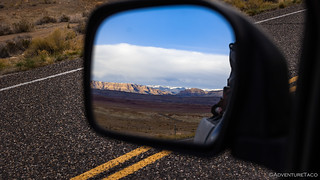
Some nice views to the west, and we hoped that in the battle between sun and clouds, that we'd end up with a few puffy white balls in an otherwise blue sky.
Heading east, we had approximately 15 miles of pavement - first on Moore Cutoff Road, then on I-70 - to our next destination at the Head of Sinbad. As we joined I-70 east, we began to climb. I suppose, looking back on it now, that we were climbing the western side of the San Rafael Swell, so technically the "unexpected" landscape we'd experienced the last two days simply meant that we hadn't yet really arrived.
As ground began to level out, an overlook presented itself, and while we don't generally stop at roadside viewpoints, for some reason I took the exit. Moments later, we found ourselves perched high on a limestone layer of the Carmel formation - prevalent across the Colorado Plateau - which formed in an ancient inland sea. As the sea covered giant sand dunes, they eventually turned to massive deposits of Navajo Sandstone. Here in the San Rafael Swell, erosion has cut the Navajo Sandstone into great white monoliths, knobs, and canyons, with the rock layers dipping slightly to the west. With erosion cutting and sculpting the rock over millions of years, the monoliths will become knobs, the knobs will become mounds, and the mounds will eventually succumb to erosion and disappear. Even the cliff from which this photo was taken will be worn away, and we may once again be standing at the bottom of the ocean.

This is the San Rafael Swell I was expecting.
After enjoying the view for a few moments, a little voice in the back of our heads suggested that we should get a move on - we had a lot of ground to cover - and we hopped back into the Tacoma for the final few miles to the center of the Swell and the Head of Sinbad.
Inexplicably, no exit existed, so we took the first one that presented itself - Temple Mountain Road - and backtracked on dirt until we came to a relative rarity, a tunnel under the freeway!

This colorful road cut was enough to make me stop and admire.

It's not every day that the sanctioned freeway underpass doubles as a culvert.

As we approached the Head of Sinbad, I was really looking forward to the change in terrain. Driving through these monoliths and canyons was exactly what I'd been hoping for!
Before setting off on our trails for the day - what I hoped would be a nice break from the onslaught of petroglyphs and pictographs we'd enjoyed for the first couple days of our trip - we had a couple things to check out.
Pictographs, obviously! 

The first panel we came to had seen better days, the entire top half of the panel having collapsed after the art was created.
We spent longer at this first panel than we'd planned, as there was a Barrier Canyon Style (BCS) shaman that we were hoping to find - but couldn't. After a good twenty minutes, we finally decided to cut our losses and head to the next location, where we promptly found what we'd been looking for a half mile away!

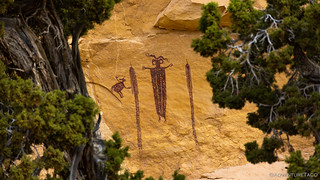
Snagged my ‘typical’ photo of this shaman at the Head of Sinbad through the tree in front. Pretty much everyone seems to take the photo this way, so I figured I might as well too!

On closer inspection, perhaps this should more accurately be called the Skeleton Shaman,
or The Snake Who Tells Time.

Nearby, more BCS from the Archaic People, though years of water have erased some of the detail to the left.
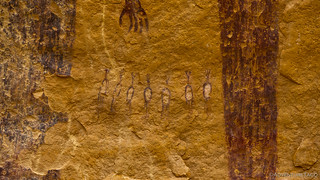
I was most intrigued by the seven chickens between the two figures.
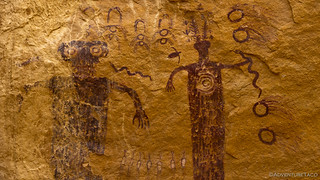
The snake-wielding figure on the right may be the first work ever to be branded with a Copyright logo.
After visiting Falling Man in Gold Butte National Monument, I've enjoyed trying to capture rock art with a bit more context rather than as a perfectly straight shot. To me, it seems to add a bit more visual interest, since rock art is so often found on rocks that are themselves spectacular.

A final shot of the shaman from a different angle.
And with that, we wrapped up the pictographs. Mostly. Sort of. Well, for a few hours anyway.
Headed north, we were now on a four-trail loop through the heart of the San Rafael Swell. The plan - if we could do it - was to follow Devil's Racetrack to Coal Wash to Fixit Pass and finally to Neilsen Dugway, ending up where we started. I say "if we could do it," because prior to departure, I'd learned that Fixit Pass had been unfixed by storms a few months earlier, and a couple of the videos I'd seen were somewhat hairy looking. Enquiries on various forums and groups hadn't yielded much in the way of information, so I knew that we could find ourselves backtracking if the road was impassable.
I had no idea at the time, but Fixit Pass would be a walk in the park compared to Devil's Racetrack. But now I'm getting ahead of myself. First, we had an arch to check out.

Dutchman Arch, or a part of it at least.

In the right place at the right time. This silhouette and glow of the arch caught me off-guard, since usually shooting into the sun doesn't work out all that well.
With Dutchman Arch in the rear-view mirror - or more appropriately, side view, since the rear is blocked and useless due to the tent - we took note of the "most difficult" sign at the beginning of Devil's Racetrack and cockily commented to each other that the sign was meant to warn off the Subaru Forrester's. And yes, looking back now, I feel as though a phrase about counting chickens might be appropriate.
At any rate, the first part of the trail was certainly more technical than anything we'd driven so far, but it wasn't all that challenging as far as I was concerned.

A few small ledges and plenty of slickrock made the going slow and bumpy, but not overly difficult. At this point, I'd have rated the trail as being similar to Moab's Top of the World.

Mostly, we were focused on the views, though these would be nothing compared to what was to come.

The new Alcan leaf springs got little workouts here and there.
As we made our way further and further into the Head of Sinbad, the trail got trickier and more technical. Still, at this point it wasn't anything I was worried about as the increase in difficulty was a bit like sitting in a pot of water being brought to a boil - you don't really notice until it is too late.
Plus, as the difficulty increased, so did the beauty of our surroundings, and we were both really enjoying the change in scenery.

What a treat - and the sun was coming out too!

Every corner we turned, monoliths and canyons rose and fell in the distance.

Larger ledges started to appear here and there, but they were - at this point - mostly downhill and not all that imposing.

It's hard to tell from this angle, but this is a Top of the World style overlook of a deep canyon that winds its way through the San Rafael Swell. I can't say my passenger was thrilled to have the truck in this position.

A quarter of the way into Devil's Racetrack, we were pretty jazzed. Views don't get a lot more spectacular than this.
It was just before we reached the Devil's Backbone that things started to get a little hairy. And by a little, I think @mrs.turbodb would say, more than enough. Certainly, there were several places that required skill and a good line in order to avoid prolific use of skid plates and sliders. And, as the trail worked its way out onto the very edge of the canyon wall, there was one spot that created one of the most off-camber situations I think I've ever experienced.

Working our way along the beginning of Devil's Backbone.
With plenty of traction on the slickrock, the Tacoma performed well, doing nearly everything I asked of it the first time, and only requiring me to have a get-out-and-look-see in a couple of places - just to make sure I understood my tire placement before attempting a particularly tricky section. Still, the trail was definitely living up to its rating, and I nonchalantly asked @mrs.turbodb what we would have done if we'd happened on a trail like this back when we undertook our first adventure on the Oregon Backcountry Discovery Route (OBDR).
No question about it, we'd have considered it impassable.
To her credit, @mrs.turbodb rattled off a few of the most useful modifications to the Tacoma in the last several years - larger tires and experience being the most important - that made this only considerably terrifying for her.

Devil's Monument.

Green trees, orange slickrock, white snow and blue skies. While the trail had its challenging sections and always required two hands on the wheel, I'd say it was worth it.
Having successfully completed Devil's Backbone, I think it's safe to say that we were both hoping that the worst was behind us. For me, this was really a function of being a single vehicle - though as the day would progress, we'd see several other people on the trail. But rather than get easier, we shortly found ourselves at a set of ledges that stepped up a rise about 2- to 3-feet at a time, spaced approximately as far apart as the wheelbase of a 1st gen Tacoma. A bypass looked a bit easier - until it reached a vertical 4-foot ledge with sand at the top and bottom - making it a non-starter in my opinion.

Starting up the stairway.
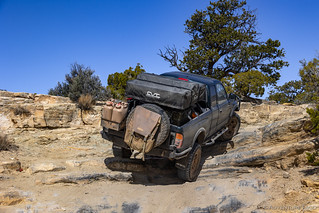
Some places got a bit off-camber, but trailing tires gripped easily to right the situation.

If only this were the top.

The last ledge was the tallest.

Up we go. On the second try, and with the front locker.
We didn't know for sure at the time, but we definitely hoped that the worst was behind us at this point. It was only 11:30am, but the constant adrenaline over the last couple hours had both of us hungry, and we decided it was time to find somewhere with a view - and ideally some shade - to enjoy a tuna sandwich.

A familiar butte, that we'd been driving towards all morning.

Getting closer.

Finally, we found a nice wide spot in the trail with a juniper tree providing shade, and it was time for lunch!

As @mrs.turbodb assembled sandwiches, I looked down into the canyon and spotted Slipper (Swayze's) Arch, which we'd be driving by a little later.
Having already spent three hours on the first of four trails for the day, we ate lunch relatively quickly so we could get back underway. Thankfully, the segment of the trail after lunch turned out to be less technical, so we made good time - except that someone kept stopping for photos - as we ticked off the miles towards Coal Wash.

There were a few more (relatively) easy ledges.

Some small rocks here and there.

And views. This, obviously(?) is Joe and His Dog.

The Golden Gate.

Another view of Joe and His Dog, with the back side of Devil's Monument
Eventually we found ourselves descending off of the ridges that we'd been following and down into the washes that wound their way below.

At the northern end of Devil's Racetrack, the skies weren't looking all that inviting, but we hoped that the wind would blow them past us to the north.

As we turned south into Coal Wash, we quite literally left the storm behind us.
Having completed Devil's Racetrack without incident, I'd say we were both relieved, though there was still a voice in the back of my head, nagging about the conditions on Fixit Pass. My only real concern at this point was that we might have to retrace our steps, if for some reason we couldn't make it out the planned route. For now though, we enjoyed the smooth surface of the sandy wash, the skinny pedal seeing more use than it had all morning.

A golden glow all around us, I could drive through these sandstone rocks forever.
We arrived at Slipper (Swayze's) Arch about 30 seconds after a group of UTVs approached from the other direction. Knowing there wasn't anything but Fixit Pass ahead of us, they confirmed that they'd come that way. Happy for some intel, I asked how they'd compare it to Devil's Racetrack. "About the same," was the response, which actually made me feel better, since the racetrack had been technical but hadn't really given us any trouble.

Slipper (Swayze's) Arch is so large that it is not best viewed from below. Perhaps a flying camera would do this arch more justice.

Nearly to Fixit Pass, with new colors presenting themselves all the time.
As we turned out of Coal Wash, the unfixed part of Fixit Pass presents itself immediately. Steep and a little rocky, my relief upon seeing it was palpable. This was most certainly not going to be an issue, and I actually felt a bit sorry for the UTV folks if they though Devil's Racetrack would be more of the same.

Beautiful, but not difficult.
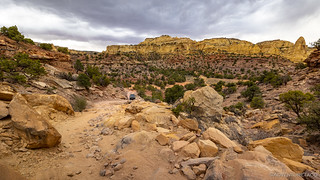
Compared to what we'd been through, and how I'd built up Fixit Pass in my mind, these football-sized rocks were a welcome surprise!
Cresting the pass, the scenery changed again. Here, the trail jogged north, pointing us once again toward the storm that was passing overhead, the clouds adding a nice bit of drama to the much redder landscape in which we were now immersed.

Smooth sailing from here. Unless it starts to rain, I suppose!

The clouds were looking nice over a cave in the bright yellow sandstone.

A three-finger salute from the San Rafael Swell.
Now about 50% of the way through our four-trail loop - and with it nearing 2:30pm - we pressed on. I was pretty sure that the rest of the route would be much quicker, but I didn't want to take any chances, and I still had a few more things on the day's itinerary - hopefully - when we were done.

A battle raged above us, between blue sky and gray clouds. The wind was blowing so hard that the situation seemed to change every few minutes.

I have to say, with sun still streaming in under the darker clouds, things were looking nice in the Swell today.
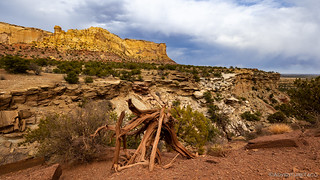
This mangled tree carcass had seen better days.

Nature's amphitheater. I'd have loved to hike over to it - to gaze up at the water stains, to search for rock art - but we didn't have time today.

In the distance, the conical Wickiup.
Less than half an hour later we wrapped up our time on Fixit Pass, and transitioned to the Nielsen Dugway. It wasn't much of a transition - except for the name - as the trail difficulty and surroundings stayed pretty much the same. After a quick chat with the occupants of a couple UTVs - one of them cracked a rim somewhere on the trail, and they'd both neglected to bring a spare - to ensure that they had someone coming with a replacement, we tackled the last several miles to great delight.
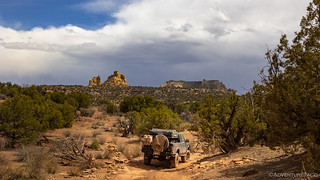
Did I say great delight? I meant great sunlight.
Even with the fantastic lighting, the highlight of the Nielsen Dugway was thanks entirely to my copilot, who - in some way I still can't figure out - spotted a trio of bighorn sheep more than half a mile away. To our delight, the road would take us directly under their position, and I hoped that our lower standing would give them confidence to refrain from running off.

What 'cha doing down there you guys?

Sentinels of the San Rafael Swell.
In no time, we neared the final ascent of the dugway back to our starting point at the Head of Sinbad and I-70. Yet again the ground under tire changed colors, and appeared to do so several more times before we were done!

So many colors.

One dust does not match the other.

Just as we were about to leave the Head of Sinbad behind, the sun came out one final time.
Where the first quarter of the loop had taken us the better part of both the morning and early afternoon, the remaining three quarters of our route had flown by, leaving us plenty of time to head south - way south - to find camp near Temple Mountain. After, of course, we hunted for a few more pictographs.
Because you can never have too much rock art. Mostly. Sort of. 
The loop I described here is a fantastic one that I feel showcased some of the best scenery that the San Rafael Swell has to offer. That said, I highly recommend running it - or at least running Devil's Racetrack - with two or more vehicles due to the difficulty of the terrain. Single vehicles can run the loop in the opposite direction, from Nielsen Dugway to Fixit Pass to Coal Wash, and then either return the way they came or continue north in Coal Wash to Ferron.






The narrative and the pictures are addictive. Thanks.
I can’t imagine handling the adrenaline rush climbing that staircase.
Thanks Joe, glad you enjoyed the pics and story! It was definitely something that had me shaking a bit when I got to the top... and wondering if there was more to come! A bit of type 1 and a bit of type 2 fun, for sure! ? ?
We visited the Swell in early October, and visited the Head of Sinbad pictographs. Coincidentally, the day before, we saw a herd of bighorn sheep near camp. In the evening light, their white butts glowed! After seeing the “chickens” between the pictograph figures, we all decided they were,big horn sheep, not chickens! Amazing coincidence.
OMG, you're right! That's fantastic, thank you so much for sharing that realization! Amazing how the right light/perspective in real life can open our eyes to seeing the ancient rock art in an entirely different way.
Have you spent much time in the Swell? Any favorite places (that you're willing to share)?
No, it was our first time! Our friends’ second time. We actually were very inspired by your trip! We did spend 3 nights camped in Crack Canyon before the trail starts. It’s the road off Behind the Reef road, before you get to the official trailhead. Honestly, we stumbled on it! We based ourselves there for three nights and hiked Wildhorse, Crack and Chute. Chute was my favorite!